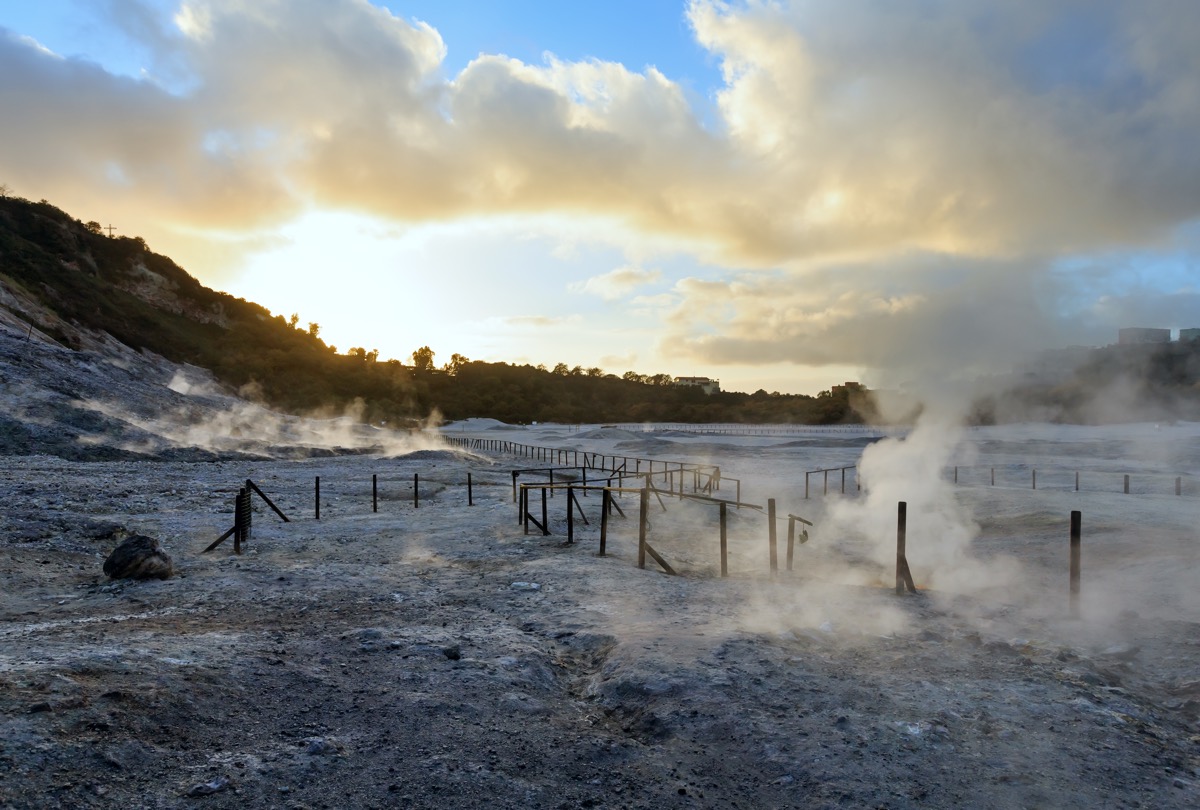Italy's Supervolcano Builds Up Stress — But No Eruption Coming

A long-quiet supervolcano in Italy, located in an area inhabited by hundreds of thousands of people, may be more stressed than previously realized, new research finds.
The study isn't cause for panic, though — just cause for readjusting expectations about what the 7-mile-across (12 kilometers) caldera called Campi Flegrei might do before its next eruption, researchers said. (A caldera is a depression formed from the collapse of surface material due to past eruptions; it isn't a single volcanic cone like Mount St. Helens in Washington, so many people make their homes within its boundaries.) Campi Flegrei last erupted in 1538 after a long period of unrest, and it has had a few short periods of seismic activity, in which the ground beneath the caldera would push upward due to impinging magma, since the 1950s.
"All we are saying is that should another rapid uplift occur in the future, calculations about the probability of an eruption and of a return to persistent local seismicity will need to be revised," study author Christopher Kilburn, the director of the Hazard Centre at University College London, told Live Science. [Big Blasts: History's 10 Most Destructive Volcanoes]
Eruptive history
If that sounds wonky, it is. But it's also important. Campi Flegrei is a large caldera, sometimes called a "supervolcano," that sits outside of Naples, Italy, and partly under the Gulf of Pozzuoli. At two points in the past — about 36,000 years ago and 15,000 years ago — the caldera erupted quite violently. Its eruptions in recorded history though, have been fairly tame. The last one, in 1538, simply formed a small cinder cone called Monte Nuovo.
"The type of eruption this could be leading to is not like the big one 30,000 years ago," said Erik Klemetti, a volcanologist at Denison University in Ohio who was not involved in the research.
Still, around 350,000 people now live in Campi Flegreiand another million live next door in Naples, so another small eruption would be disruptive, Kilburn said.
Kilburn and his colleagues were also interested in studying Campi Flegrei's dynamics, because more than 130 other similar calderas around the world have been active in the time since humans started leaving records.
Sign up for the Live Science daily newsletter now
Get the world’s most fascinating discoveries delivered straight to your inbox.
A second look at Campi Flegrei
The researchers developed a new model for understanding the volcano's periodic rumblings. Since 1950, Campi Flegrei has had three periods of seismic unrest: between April 1950 and May 1952, between July 1969 and July 1972, and between June 1982 and December 1984. During each of those periods, the ground would pulse upward by about 1 to 2 feet (0.3 to 0.6 meters) per year, for a total uplift of about 9.8 feet (3 m).
This uplift was probably driven by injections of magma from a reservoir 4 to 5.5 miles (7 to 9 kilometers) deep into layers closer to the surface, about 1.8 miles (3 km) deep, Kilburn said. Such magma puts stress on Earth's outer layer, the crust, as the material squeezes into available subterranean spaces, causing tiny earthquakes and uplift, he said.
The assumption, Kilburn and his colleagues wrote May 15 in the journal Nature Communications, was that the stresses that accumulated during these periods of uplift dissipated between those periods, essentially resetting the caldera to zero. Now, Kilburn and his colleagues have used their new modeling technique and data taken from a drilling project at the volcano to argue that about 80 percent of the stresses accumulated during these uplift periods remain in the crust. That accumulated stress makes the caldera more prone to shaking and breaking than previously believed, the researchers said.
This does not mean an eruption is imminent, the scientists said, as Campi Flegrei is currently quiet. Its last activity report on the Smithsonian Institution Global Volcanism Program's website describes a swarm of tiny, magnitude-1.9 quakes back in 2012. But if Campi Flegrei were to wake up again, the volcano might be preloaded with enough stress to make it shake more and erupt more readily than previously expected, the researchers said.
"This idea of stress accumulating at the crust in volcanos is a fairly new idea of how to look at the events leading up to an eruption," Klemetti said. This is interesting, he said, but it's possible that the older interpretations are correct and the volcano's restless periods might be discrete events that don't add up to anything.
Kilburn said the same model has accurately described volcanic activity at Mount Pinatubo in the Philippines, Soufrière Hills on Montserrat in the Caribbean, Kilauea on Hawaii, and Rabaul in Papua New Guinea.
Original article on Live Science.

Stephanie Pappas is a contributing writer for Live Science, covering topics ranging from geoscience to archaeology to the human brain and behavior. She was previously a senior writer for Live Science but is now a freelancer based in Denver, Colorado, and regularly contributes to Scientific American and The Monitor, the monthly magazine of the American Psychological Association. Stephanie received a bachelor's degree in psychology from the University of South Carolina and a graduate certificate in science communication from the University of California, Santa Cruz.









